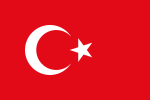 | some of these ancient peoples to Turks is possible, it is rather unlikely. In the 19th century, the word Türk referred to Anatolian peasants. The Ottoman... 237 KB (24,478 words) - 22:26, 9 May 2024 |
 | Besides Hittites, Anatolian peoples included Luwians, Palaic peoples and Lydians. They spoke Anatolian languages. Other incoming people include Armenians... 10 KB (897 words) - 20:53, 25 April 2024 |
 | Indo-Aryan peoples are a diverse collection of peoples speaking Indo-Aryan languages in the Indian subcontinent. Historically, Aryans were the Indo-Iranian... 19 KB (1,521 words) - 13:15, 4 May 2024 |
 | Anatolia (redirect from Anatolian Peninsula) Balkan peninsula of Southeastern Europe. The ancient Anatolian peoples spoke the now-extinct Anatolian languages of the Indo-European language family, which... 72 KB (7,269 words) - 21:28, 15 May 2024 |
 | Anatolian beyliks (Turkish: Anadolu beylikleri, Ottoman Turkish: Tavâif-i mülûk, Beylik; Turkish pronunciation: [bejlic]) were small principalities (or... 16 KB (1,579 words) - 13:31, 16 March 2024 |
 | peoples were an ethnolinguistic group identified by their use of Italic languages, a branch of the Indo-European language family. The Italic peoples are... 24 KB (2,599 words) - 17:19, 1 May 2024 |
 | The Anatolian hypothesis, also known as the Anatolian theory or the sedentary farmer theory, first developed by British archaeologist Colin Renfrew in... 23 KB (2,661 words) - 02:57, 4 April 2024 |
related to the region Anatolia Anatolians, ancient Indo-European peoples who spoke the Anatolian languages Anatolian High School, a type of Turkish educational... 926 bytes (150 words) - 20:19, 14 February 2024 |
 | Hittites (category Anatolian peoples) The Hittites (/ˈhɪtaɪts/) were an Anatolian Indo-European people who formed one of the first major civilizations of Bronze Age West Asia. Possibly originating... 97 KB (11,240 words) - 18:55, 15 May 2024 |
 | Turkey (section Seljuk and Anatolian beyliks period) Turkey was inhabited by various ancient peoples. Hattians were assimilated by the incoming Anatolian peoples. Increasing diversity during Classical Anatolia... 321 KB (28,661 words) - 03:43, 16 May 2024 |
 | Hattians (redirect from Hattian people) imposed by the Hittites, who were one of the Indo-European-speaking Anatolian peoples. The Hittites kept the country name ("land of Hatti") unchanged, which... 14 KB (1,670 words) - 15:32, 2 May 2024 |
 | Kurgan hypothesis (redirect from Kurgan (people)) tried to align the Anatolian hypothesis with the steppe theory. According to Piazza, "[i]t is clear that, genetically speaking, peoples of the Kurgan steppe... 34 KB (3,825 words) - 14:41, 30 April 2024 |
 | North Germanic peoples, Nordic peoples and in a medieval context Norsemen, were a Germanic linguistic group originating from the Scandinavian Peninsula... 91 KB (10,684 words) - 21:22, 29 April 2024 |
(in Turkish). Retrieved 19 February 2023. "'New human rights plan for the people': Turkish leader". Anadolu Agency. Retrieved 6 March 2021. "Erdoğan unveils... 5 KB (187 words) - 08:23, 23 April 2024 |
Luwians (category Anatolian peoples) 1190 BC at the hands of Assyria and Phrygia.[citation needed] Western Anatolian kingdoms such as Seha, Arzawa, and Wilusa may have had at least partially... 17 KB (1,781 words) - 00:32, 16 April 2024 |
 | Celts (redirect from Celtic peoples) pronunciation for different usages) or Celtic peoples (/ˈkɛltɪk/ KEL-tick) were a collection of Indo-European peoples in Europe and Anatolia, identified by their... 146 KB (16,575 words) - 03:51, 31 March 2024 |
 | Indo-European languages (redirect from Indo-European peoples) including the Indo-Aryans, Iranian peoples, Celts, Greeks, Romans, Germanic peoples, and Slavs, led to these peoples' branches of the language family already... 111 KB (10,137 words) - 12:14, 15 May 2024 |
 | Lud, son of Shem (category Book of Genesis people) descendants of Lud are usually, following Josephus, connected with various Anatolian peoples, particularly Lydia (Assyrian Luddu) and their predecessors, the Luwians;... 4 KB (399 words) - 14:35, 1 March 2024 |
 | Indo-Iranians (redirect from Indo-Iranic peoples) The Indo-Iranian peoples, also known as Ā́rya or Aryans from their self-designation, were a group of Indo-European speaking peoples who brought the Indo-Iranian... 56 KB (5,229 words) - 22:17, 8 May 2024 |
 | together as peoples that migrated to Anatolia from the Balkans. This image of Phrygians as part of a related group of northwest Anatolian cultures seems... 53 KB (6,343 words) - 20:16, 6 March 2024 |
 | Indo-European migrations (section Anatolian hypothesis) as the 8th century BCE. The lands of the Anatolian peoples were successively invaded by a number of peoples and empires at high frequency: the Phrygians... 270 KB (28,988 words) - 16:37, 27 April 2024 |


